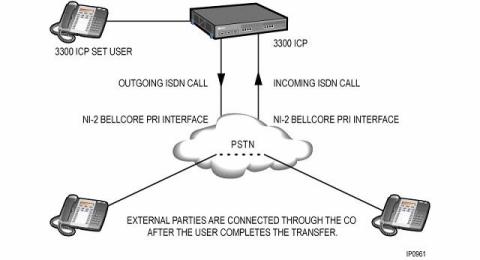
Two B-Channel Transfer (TBCT) allows a 3300 ICP set user to transfer an external call to another external destination and have the two external parties connected through the trunks at the Central Office (CO). Because the calls are connected at the CO instead of at the 3300 ICP, the incoming and outgoing trunks on the 3300 ICP that would normally be required to connect the external parties are available for use.
TBCT is only supported for Bellcore and 5ESS variants of the NI-2 protocol for the embedded ISDN offerings of the 3300 ICP. It is not supported on the NSU.
TBCT Transfer

The 3300 ICP supports the tagging of TBCT calls by the CO. You can enable SMDR to record these tags and then use the tags to track the costs of TBCT calls. When the user initiates the transfer and the system releases the trunks, the CO sends the 3300 ICP a unique tag. SMDR appends this tag to the call record of the incoming trunk call. After the external call clears down, the CO then sends the same tag again to the system. SMDR then generates another record with this tag to identify when the external call cleared down. See SMDR Examples.
Note: Calls are charged as if the transfer had not taken place.
If the two ISDN trunks are located on the same system, the SMDR records for both of the ISDN trunks will contain the tag. In the case of a network transfer, the ISDN trunks are located on different systems and the systems are connected via DPNSS or IP trunks. In this case, the tag is written into the SMDR records of both trunks (ISDN and DPNSS or IP trunk) on the system that hosts the ISDN trunk that was on hold at the time that the transfer was initiated.
Network TBCT Transfer

You must purchase support for TBCT from the CO.
TBCT must be enabled at the CO. If the feature is not enabled, a TBCT request from the 3300 ICP is ignored and the trunks are connected together through the 3300 ICP.
TBCT only works on trunks that are in the same Central Office PRI group. It does not work between Central Offices.
TBCT functions on a local 3300 ICP or across a private MSDN/DPNSS network.
Currently, the maximum number of active transfers supported by the CO is 127. If the maximum number of active transfers is already in use, a TBCT request from the 3300 ICP is ignored and the trunks are connected together through the 3300 ICP.
Interconnect, Tenanting, and COS restrictions that currently prevent CO trunk calls from being transferred together also prevent TBCT calls.
Enable "Two B-Channel Transfer Allowed" in the Class of Service Options form of the device (attendant console or set).
To enable SMDR recording of TBCT calls, set the following options to "Yes" in the SMDR Options form:
SMDR Extended Reporting Level 2
Two B-Channel Transfer Recording
If TBCT is being performed in a network, also set the following options to "Yes":
Standard Call ID Format
Standardized Network OLI
A user can initiate a TBCT from any device that can transfer a trunk call or form a trunk-to-trunk conference.